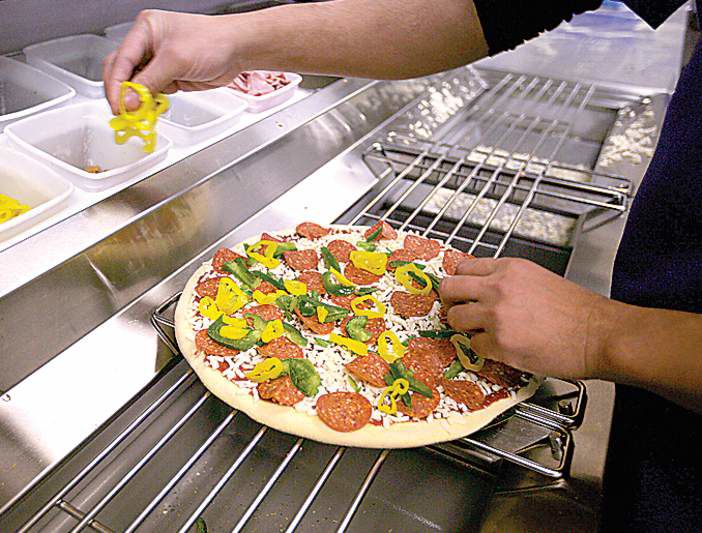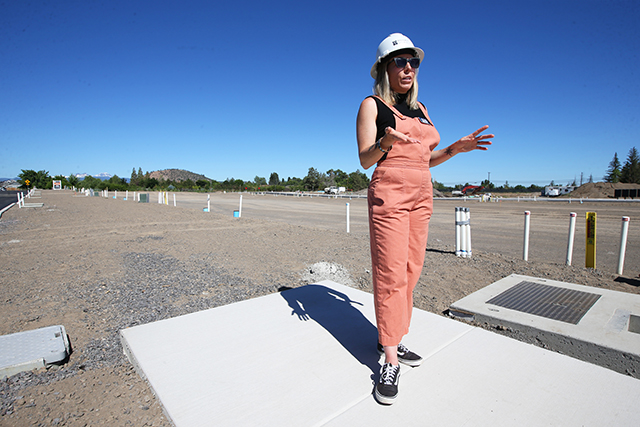Pizza chains compete for bigger slice of consumer pie
Published 4:00 am Sunday, January 2, 2011

- West Lopez, 40, makes a custom pizza at Domino’s Pizza in Farmington Hills, Mich., on Dec. 2. The national chain revamping its recipe seems to have triggered competition among fast-food-pizza chains.
DETROIT — To some, it may have been a cheesy ad.
The underlying theme of Domino’s Pizza’s recent national marketing campaign was that people disliked the company’s old pizza recipe. The advertisements announcing an improved pizza taste worked — and were the first volley in the latest round of pizza marketing battles.
Trending
In what some might view as a response — though they themselves do not — Little Caesars brought its Pizza! Pizza! campaign back.
Other major pizza players also unveiled new products and approaches this past year.
“This will remain a competitive category,” said Janney Capital Markets research analyst Mark Kalinowski. “Pizza’s probably held its own in terms of total market share as compared to the rest of the restaurant industry. … All in all, pizza’s not in a bad place at all.”
A tastier sauce, a better cheese combination, flavored crust, olive oil, a new crust thickness.
Those are some of the ingredients needed for an improved pizza recipe — and for an epic pizza battle.
America’s largest pizzeria chains are duking it out across counters and doorsteps, as ever-budget-conscious people, still recovering from the recession, continue to look for cheap fast food.
Trending
But most notably, in this pizza war, the doughboys are fighting not only across the country, but across town, as two of the country’s biggest chains — Domino’s at No. 2 and Little Caesars at No. 4 — are Detroit-area companies.
Their weapons? Domino’s has a revamped pizza recipe, introduced last December in a much-discussed ad campaign, that has translated into higher sales; for example, its 2010 third-quarter same-store sales were up 11.7 percent over the comparable period in 2009.
Little Caesars’ spear is the Nov. 1 introduction of Pizza! Pizza! Pantastic: Two Hot-n-Ready pizzas, one supreme and one pepperoni, for $9.99. The com- pany is privately held and declined to share sales information but said it was reaching its goals.
“It’s going to remain a very competitive sector, in part, because you have multiple national players and you have a lot of strong regional players and on top of that, a lot of very good mom-and-pop operators,” said Kalinowski.
“In the aggregate, we have multiple industry sources saying smaller players are losing a lot of market share this year. That suggests their sales trends have not been nearly as good as Pizza Hut or Domino’s. It’s doing a lit bit better than the average restaurant sector, but again that’s through the strength of Pizza Hut, of Domino’s. This is not a case of a rising tide lifting all boats.”
Last year, Americans spent close to $36.3 billion on pizza, according to PMQ Pizza Magazine, an industry trade magazine. More than 8 percent of that went to Domino’s coffers and 3.11 percent to Little Caesars. Of the 64,951 pizzerias open in this country as of March 2010, 42 percent are owned by the top 50 chains and control 48 percent of the sales. Pizza Hut, based in Dallas and a subsidiary of Yum! Brands, ranks highest, but three other Michigan pizzeria chains are in the Top 50, Hungry Howie’s, Jet’s and Bellacino’s.
“It’s definitely the latest installment; they were already warring with one another over price,” said Jeremy White, editor of Pizza Today, another trade publication. “Domino’s obviously changed the game. They came out and said, ‘We’re making a massive overhaul to our core product. We don’t think it’s as good as it could be or should be, and the public doesn’t think so either.’ It earned them so much goodwill and credibility that’s now paying off. That was a risk and it’s paying off. You haven’t seen other companies doing as much.”
Nancy Childs, a professor of food marketing at St. Joseph’s University in Philadelphia, sees the fight as part of a larger trend.
“They are intensive competitive marketers; they’re going to try to mimic each other and one up each other’s offerings, whether they’re competing on quality of ingredients and formulation and the latest deals,” she said. “To the degree they’re going to go national, they’re going to be competitive. You see that with Pepsi and Coke. You see that with the car manufacturers.”
The real dough
Both Little Caesars and Domino’s declined to say how much they spent on advertising.
Kantar Media, a marketing and analysis firm, calculated that Little Caesars spent close to $11.9 million on advertising in 2009 and an estimated $12 million between January and September of this year, while Domino’s spent more than $171 million last year and approximately $121.1 million during the first nine months of 2010.
The U.S. pizza restaurants and delivery services industry, as a whole, spent more than $545 million on advertising last year, according to the same report.
Brandon Solano, Domino’s vice president of innovation, called the bad economy a headwind in Domino’s gains, but also stressed that his company’s marketing campaign about its updated flavor profile impressed customers with its honesty. After all, thousands of products are improved every year, but without fanfare.
“The pizza industry has seen a lot of competitors following one another. If they’re successful, you see them follow one another,” he said. “Coming out with a new recipe speaks to leadership not followship. … There were a lot of people who were looking for something better, and we gave it to them.”
According to Solano, Domino’s menus have changed 80 percent in the last year and half, thanks to new products and tweaks, though the new recipe — the result of 45 different trials — marks the first major overhaul since the company launched 50 years ago. The business was once pizza and a Coke and he said company legend includes a story about Domino’s reluctance to even introduce Diet Coke to the menu, afraid it would complicate operations.
“Consumers’ tastes have changed,” he said. “There’s more diversification of food. You’re seeing third-graders bringing sushi to school. They’re more demanding.”
But Little Caesars sees it as they’re getting it right the first time.
“We like to think our product is perfect the way it is,” said Brian Pattison, Little Caesars’ vice president of the Midwest zone company operations. “We’ve held fast to what our product is. Our customers seem to be telling us (they like it) just the way it is.”
The company’s seeing the positive response to its new deal, which offers pizza said to be 46 percent larger than competitors’.
“We’ve been looking at a way to provide more variety for our customers for a while,” Pattison said. “Hot-n-Ready is doing well, but customers were kind of telling us they need more variety, and we thought this was the perfect time to bring back Pizza! Pizza! and offer it Hot-n-Ready. … Our coping mechanism is always to focus on what our customers want and focus on value.”
The sluggish economy also means the pizza is appealing to a wider variety of potential consumers, not just the traditional three C’s — college students, cheapskates and Cub Scouts.
“This is a good value meal, and people are looking for that,” Childs said. “If people can’t afford a restaurant out, they can still afford the pizza to take them out of the kitchen. This is the time when you’re looking to expand your market share to get more customers, so it makes it even more intense.”
When pizza prices are cut, toppings may be trimmed, too
No matter how you slice it, competition is fierce in the crowded pizza business.
With an estimated 64,000 pizzerias in the United States — not counting all the bars, bowling alleys and warehouse clubs that also sell pizza — every place wants a bigger piece of the market, and one way to increase sales is to offer better deals than the competitor down the street.
But what’s happening behind the scenes when pizza-makers cut prices or offer what appear to be almost unbelievably good deals?
Some pizza chains known for low prices simply use fewer toppings than competitors, says Steve Green, publisher of the trade journal PMQ Pizza Magazine and a former Domino’s franchisee.
He says there’s an inescapable connection between prices and food costs (the percentage of every dollar that is used to pay for ingredients). On average, he says, most pizzerias have food costs of 25 to 30 percent and labor costs of 20 percent, leaving the 50 percent or so as gross profits.
“But everybody has to run those food costs,” he said. “There is no beating the market. If you have generous toppings and expensive cheese, you will have a high-costing pizza.”
Brandon Solano, Domino’s vice president for brand innovation and head chef, says some of his competitors have reduced the usual amounts of toppings they use when they’ve cut prices.
He knows that, he says, because his company buys other chains’ pizzas and analyzes the ingredients. It was Solano who headed the re-engineering of Domino’s core pizza recipe, resulting in double-digit sales increases this year. (Little Caesars representatives declined to discuss product-development issues, and Pizza Hut officials did not return calls.)
One thing pizza makers usually don’t do in a price war is tamper with key items such as cheese, says Liz Barrett, PMQ’s editor in chief. That’s because “they’ve based their reputations on a certain kind of pizza” and flavor profile.








